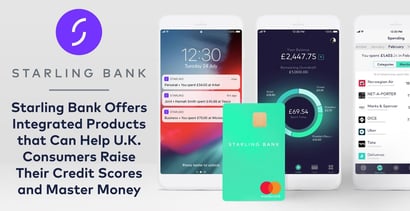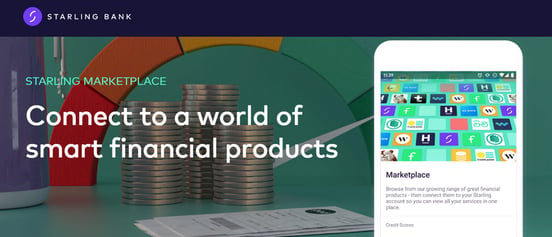

In a Nutshell: Starling Bank, a digital-only U.K. challenger bank, boasts a commitment to convenience that begins with its mobile app, which allows users to save, spend, and view transactions easily. And the bank’s marketplace takes that convenience a step further by enabling customers to integrate approved third-party financial tools into their accounts. One of those products is CreditLadder, which tracks rent payments and reports them to credit bureaus to help consumers boost their credit scores. And, as Starling Bank continues to add customers, it aims to extend the reach of those products and services to help more people meet their financial goals.
One of the main principles of design is a focus on the end-user, and products can suffer when they are too difficult to navigate. That is especially true in the fintech industry since finance is often a daunting topic for a large segment of the population.
Intuitive fintech tools that help users conveniently manage their finances could lead to more satisfaction in other areas of their lives — but many solutions miss the mark.
For example, accounting software can simplify financial calculations, but users must still download banking information from their institutions and upload it to the platform — if it’s compatible. Otherwise, they may have to enter it manually.

Starling Bank, based in the U.K., is on a mission to solve those problems and eliminate inefficiencies to provide convenient technology experiences to its customers. That’s why its app allows consumers to transfer account information to software platforms with one click — saving time and frustration.
Starling is a licensed, mobile-only bank with no brick-and-mortar branches. And that focus on digital service has yielded a robust, integrated ecosystem. Its app has an easy-to-use interface that gives users convenient control over their money.
The bank has a marketplace where partner tools expand the app’s versatility and functionality. One of those is CreditLadder, which provides renters with a way to report their timely housing payments to credit bureaus.
“I think there’s a real opportunity for Starling to redefine what banking means,” said Anna Mitchell, Starling Bank Head of Marketplace. “It’s almost like going back to basics and finding out what the customer wants and needs.”
Starling also steers clear of using inaccessible financial terminology and industry jargon, which creates a sense of transparency, fairness, and inclusion. Customers won’t find hard sells or hidden fees at Starling — just tools designed to help them lead healthier financial lives.
Mobile App Gives Users Greater Control of Their Money
The Starling app emphasizes insight and functionality to help customers take control of their money. And it was a trailblazer in the banking industry.
“We launched the first mobile-only banking app in May 2017,” Mitchell said. “We have been live effectively since then, and we have more than 1 million accounts.”
In the digital era, identity and information theft is a pervasive concern, which is why Starling helps customers stay ahead of the scammers with its card control features. The safeguards help account holders prevent fraud by allowing them to freeze their card instantly if it is lost or stolen, restrict and block online payments, and disable contactless payments. All of those options can be toggled on and off quickly within the app.
The app also makes it simple to set aside money for individual savings goals. Money dedicated to a goal still earns interest, and it can be transferred back to the user’s main account at any time. The app even offers automated options for transferring money into savings, and even rounding up purchases to the nearest pound and adding the difference to the savings goal of their choice.
Another area where the Starling app’s convenience shines is in its payment features. Its Nearby Payments option allows users to send money to other Starling customers after locating them via Bluetooth — no phone or account numbers or sort codes required. And its Settle Up feature allows customers to instantly transfer funds to non-Starling users, making splitting bills or lending money as simple as a few taps.
Finally, users can track their saving and spending through the app’s Insights function, which analyzes transactions by category and merchant. The app automatically categorizes transactions, but users can adjust item classifications manually and even attach notes, receipts, and photos. The feature also provides a comprehensive view of what users are spending each month.
The app puts Starling at the forefront of financial innovation and convenience. But the bank takes things a step further with its Marketplace, where users can explore a range of additional products designed to enhance their financial lives.
Consumers Save Time and Money Shopping in the Bank’s Open Marketplace
The Starling Marketplace includes services from select third-party providers that help customers save time and money. Offerings include tools for insurance, investing, lending, pension management, and even expense and loyalty reward tracking.
“It is about building the best possible banking experience and then partnering with best third-party providers in the industry,” Mitchell said. “The Marketplace is an opportunity to introduce our customers to a range of different financial products.”
Starling’s Marketplace is based on the open banking movement, which fosters interconnectivity and integration between fintech apps and institutions. Starling’s application programming interfaces (APIs) allow data to transfer securely between apps that otherwise could not communicate with one another. This integration creates a seamless, simple experience when dealing with financial products. Through open-banking technology, Starling combines convenience and transparency with cutting edge tools from its third-party partners.

The Starling Marketplace gives customers a chance to personalize their financial experiences.
“The vision for the marketplace is to create a range of complementary products and services,” Mitchell said. “A good example of that is the accounting integration we have with services like Xero and Free Agent. By having our public API integration in place, it allows our customers to benefit from transaction syncing between their bank account and their accounting software.”
Starling carefully selects its marketplace partners, and vets each one to ensure they adhere to the same robust standards of data privacy and information security that Starling employs. As a bank, customers place a lot of trust in its partner choices, so Starling wants to collaborate with only the best partners who can deliver great products and customer service. Partners can only access information with user consent, and the bank’s customers can choose to revoke permissions at any time.
“Unlike some of our competitors, who may seek a best-in-class partner pair application, at Starling, we believe in providing our customers a range of products they can choose from and can move through during their lifetimes,” Mitchell said.
CreditLadder Integration Can Help Renters Improve Their Credit Scores
Rent is one of the most significant payments that many consumers make regularly. But unlike other bills, including mortgages, timely rental payments don’t contribute to their credit scores. That is a missed opportunity to build and improve credit.

Anna Mitchell, Starling Bank Head of Marketplace, spoke with us about how the institution simplifies finances for users.
CreditLadder is a rent-reporting service that is free for tenants and is available in the Starling Marketplace. Its recognition technology scans and identifies rent payments in financial accounts and adds those on-time payments to a user’s Experian credit history. The service launched in mid-2019 for personal accounts, and around 1,000 Starling customers have already taken advantage of CreditLadder integration.
An improved credit score by adding timely rental payments can give consumers access to better rates and conditions on loans, lines of credit, mobile phones, and utilities. It also improves their chances of qualifying for a mortgage, which can allow them to move from a rental property into their own home.
At that point, mortgage payments can further improve their credit scores as they also build equity — both of which contribute to an improved financial outlook.
“Using open APIs and bringing different data points together unlocks additional value for customers without the customer having to do anything extra — except agreeing to share their transaction data with CreditLadder,” Mitchell said. “That’s something that showcases the power of APIs and a little bit of data science.”
Starling: Expanding Reach and Partnerships to Serve UK and Europe Customers
The Starling Bank app’s features, functionality, and integration with vetted third-party products illustrate how quality design can improve convenience and financial well-being. In 2020, Starling plans to expand its offerings to consumers throughout the U.K. and Ireland. The bank also has its sights set on extending its digital services to customers in France and Germany — among other countries.
And beyond expanding its reach, Starling continually works to improve its current offerings, especially by including more partner products in its Marketplace. Starling is now looking at ways to make its Marketplace offering smarter and more personalized to individual user needs — across all account types. In addition to this Starling will continue to expand it’s Marketplace, with ambitions to add 15 to 20 new integrations throughout 2020.
“We might be at the front, and we might see others in the industry starting to replicate some of the stuff we’re doing, but we’re not stopping,” Mitchell said. “We’re going to keep pushing the boundaries even.”
In pursuit of that goal, Starling continues to promote the integration of its public APIs. That initiative will create a better user experience and more value for customers, thereby helping them along their financial path.
“Our public API has so much high-quality data and is better structured than anything on the market. There’s so much opportunity there,” Mitchell said. “I believe we have only scratched the surface on this, and I’m excited about going into 2020. We will explore how we can build even better integrations and unlock more value.”
Advertiser Disclosure
BadCredit.org is a free online resource that offers valuable content and comparison services to users. To keep this resource 100% free for users, we receive advertising compensation from the financial products listed on this page. Along with key review factors, this compensation may impact how and where products appear on the page (including, for example, the order in which they appear). BadCredit.org does not include listings for all financial products.
Our Editorial Review Policy
Our site is committed to publishing independent, accurate content guided by strict editorial guidelines. Before articles and reviews are published on our site, they undergo a thorough review process performed by a team of independent editors and subject-matter experts to ensure the content’s accuracy, timeliness, and impartiality. Our editorial team is separate and independent of our site’s advertisers, and the opinions they express on our site are their own. To read more about our team members and their editorial backgrounds, please visit our site’s About page.
